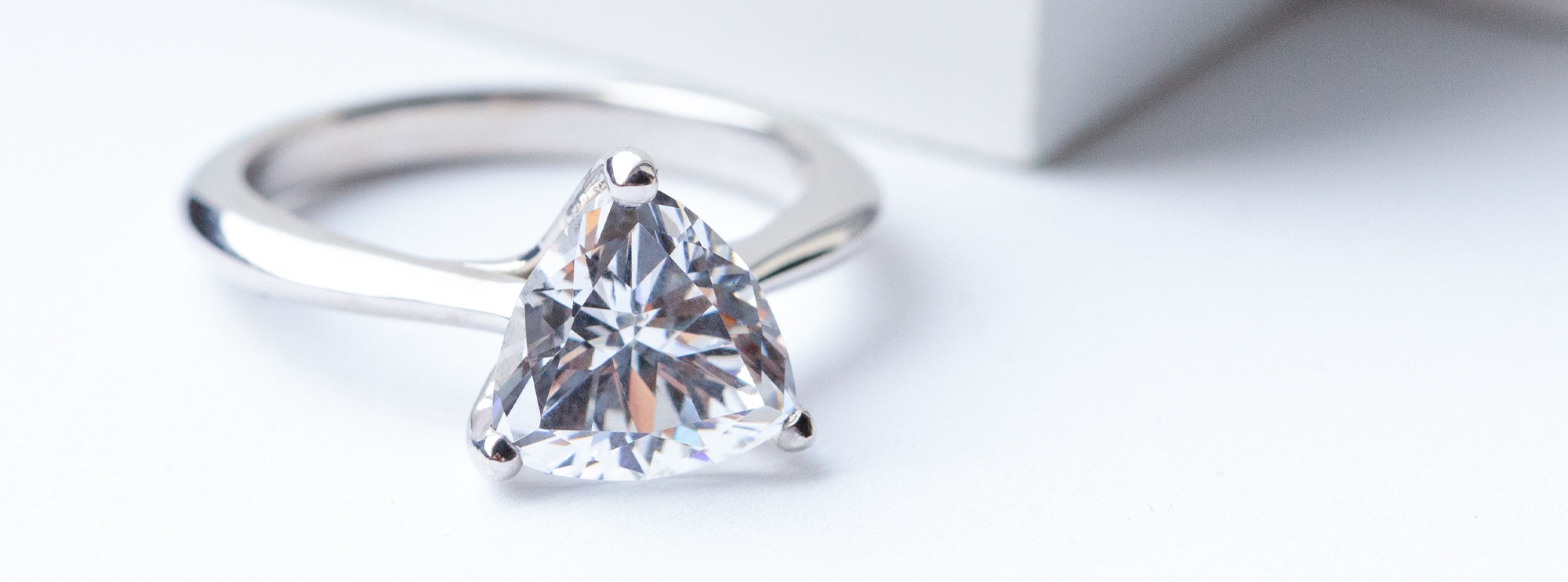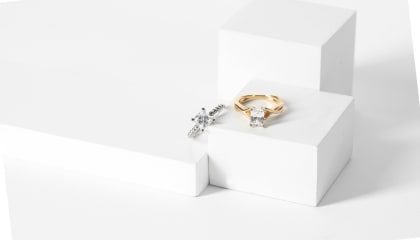A durable, eye-catching metal with a starlit shine, white gold is a relative newcomer on the jewelry scene. Originally developed in the nineteenth century, white gold got its first taste of stardom in the Roaring Twenties. It was in this decade that it arose as an alternative to platinum—a metal that was in high demand thanks to World War I.
Today, white gold remains a sought-after option for rings, necklaces, and other jewelry pieces adorned with diamond alternative stones. But because it is often outshined by its flashier siblings (yellow gold, the perennial favorite, and rose gold, a trendy newer metal), many people don’t know how to care for white gold pieces.
Unlike other precious metals, white gold doesn’t tarnish. That said, its color can fade thanks to the habitual weathering that rubs away its rhodium coating. In this blog, we’ll look at why this happens and some easy steps you can take to keep your white gold pieces shining.

What Is White Gold?
Unlike yellow gold—which is so elemental that it can be found on the Periodic Table—white gold is a manmade product. Created through an alloying process, white gold is a combination of pure gold and white metals like nickel, zinc, silver or palladium that is typically plated with rhodium for a durable, silvery finish.
When talking about the purity of gold products, jewelers use the term caratage. This refers to the percentage of pure gold versus other components included during the alloying process. A 24-carat gold ring, for example, is pure gold.
Do the math, and you’ll quickly work out that an 18-carat ring is 75% pure gold. They range from 18 carats all the way down to 9 carats (37.5% pure gold). It may not surprise you to learn that higher caratage equals higher value.
Buyers of white gold often choose this metal for its quality and appearance. They’re looking to invest in a durable, attractive piece that can stand up to typical wear and tear while requiring minimal maintenance. For many, this means the question, does white gold tarnish? is an important one when choosing a piece.
As we’ve already covered, the answer to that question is no—but it’s still important to take superb care of this metal. Let’s examine what can damage white gold and what steps can wearers take to prevent damage from happening.
The Affordable and Untarnishable Gold
Unlike other metals that can easily dull and blacken just by being exposed to air—white gold doesn’t develop the signs of oxidation and loss of luster associated with tarnishing. This is excellent news for those who are looking to purchase a precious metal piece but don’t want to spend time buffing and polishing.
However, white gold isn’t completely immune to the effects of wear. As we mentioned earlier, white gold jewelry pieces are plated with rhodium to provide extra shine and strength. Rhodium is an ideal coating for white gold plated jewelry pieces because it is:
- Scratch-proof
- Highly reflective
- Resistant to corrosion
- Hard to dent
If you’re worried about the relative value of this material used for plating, don’t be—rhodium is considered the rarest and most valuable precious metal in the world.
Rhodium plating does wear down over time, however. When too much wear happens to white gold jewelry, it can reveal the mostly yellow gold alloy beneath. So while white gold doesn’t tarnish per se, it can appear to change in color from the brilliant colorless beauty you purchased to a warmer, more traditional hue.
That said, there’s no need for alarm. Once you’ve been armed with the knowledge of what causes this gradual transition, you’ll have no trouble protecting the glossy, gorgeous sheen of your favorite white gold jewelry.
White Gold’s Rhodium Armor
Despite its formidable strength, rhodium—the protective shield of white gold—reveals a certain brittleness. This characteristic discourages the use of rhodium in rings or necklaces due to the inherent risk of cracking or breaking. While providing an exquisite reflective quality reminiscent of platinum or pure silver, rhodium faces challenges from various sources.
Contact with Other Metals: Frequent interaction with softer metals, including gold, poses a risk of damage to the rhodium coating. Rings on neighboring fingers or contact with cutlery and metal handrails are common culprits.
Abrasion from Other Sources: Everyday elements such as skin, sturdy fabric, or food can contribute to the gradual wearing down of rhodium plating. While there’s no need to remove jewelry for routine activities, mindfulness about habitual hand-wringing or exposure to abrasive substances is beneficial.
Heavy Chemicals: Household chemicals, like bleach and detergents, have the potential to damage rhodium plating. Removing rhodium-plated jewelry before engaging in deep cleaning is a prudent practice.
Chlorine: The exposure to chlorine, especially in pools, can lead to the erosion of the protective coating, resulting in a shortened lifespan for the piece.
Sweat: Minerals present in sweat can contribute to rhodium plating damage. While there’s no need to remove jewelry during light activities, setting aside favorite pieces during vigorous exercise can be a thoughtful choice.
Preserving White Gold’s Shine
Because little is known about rhodium in comparison to more popular jewelry materials, many people aren’t aware that it’s possible to replace the rhodium plating on your favorite pieces every so often.
The typical life cycle of rhodium plating is between twelve and eighteen months. This time period can be affected not only by how often you wear your jewelry, but the type of piece it is.
For example, rings generally wear out more quickly because we use our hands so often and expose them to so many substances. On the other hand, rhodium plating on white gold earrings tends to last a lot longer.
With those ideas in mind, proper jewelry care is a must. So, here are some of our top ways to extend the lifespan of your white gold jewelry:
- Remove jewelry before showering or swimming – Even the water you bathe in can contain abrasive minerals and salts. While these may be perfectly safe for your skin, it’s best not to wear white gold while showering. (This rule of thumb also extends to the pool.)
- Remove jewelry before cleaning – If you’re embarking on a heavy-duty scrubbing session, wear rubber gloves to protect rings and remove your white gold necklaces, earrings, and white gold bracelets. Yes, this is a good idea, even if you’re only washing a few dishes. You can place a special small jewelry dish in your kitchen to remind yourself not to rinse plates while wearing your favorite pieces.
- Be strategic about jewelry layering – Depending on your personal style, you may wear only a select few pieces or wear rings on every finger. Where this can become dicey is when other rings rub against your white gold chains and jewelry pieces. This can speed up the wearing process, leading to that yellow color. We recommend isolating rhodium-plated white gold engagement rings on one hand in order to avoid this issue.
- Avoid polishes, silver solutions or ammonium dips – If you own silver, you may know that an arsenal of special solutions is necessary to keep your pieces buffed and burnished. However, because of the differences between sterling silver vs white gold, you should never try to use these same products on your white gold jewelry. While some of them may be safe, the likelihood of them damaging your rhodium plating is high.
- Play it safe – Signed up for a pottery painting class? Leave your white gold jewelry at home. Heading into the garden? Put those pieces away for safekeeping first. Trust us—when it comes to luxury jewelry, it’s always a good idea to exercise caution.
While heeding these steps is an excellent way to extend the brilliance of your white gold jewelry, you may still need to re-plate your pieces from time to time. Keep in mind that this is a normal part of owning white gold jewelry. However, it can help to know what to expect with the process.
Cost of Maintaining White Gold
Understanding the financial considerations associated with maintaining white gold is crucial in the realm of jewelry ownership, particularly when contemplating the common practice of rhodium re-plating. Fortunately, numerous skilled jewelers are adept at swiftly handling this process, often completing it within a mere 90 minutes. This efficiency allows you the convenience of dropping off your cherished white gold ring during your lunch break and reclaiming it well before the onset of happy hour—a seamless and expeditious turnaround for preserving its brilliance.
The financial investment required for re-plating a white gold piece is subject to several influencing factors. These include the quality of the rhodium utilized, the level of skill demonstrated by the jeweler performing the re-plating, and the distinct characteristics of the jewelry piece itself.
While costs may exhibit some variability due to these factors, a broad estimate positions the expense for re-plating white gold jewelry within a reasonable range, typically spanning from $30 to $150. This modest investment ensures the sustained radiance of your treasured white gold pieces, representing a judicious and worthwhile solution for upkeeping their timeless allure. As you assess the cost against the enduring beauty and longevity it bestows upon your jewelry, it becomes a reasonable and prudent facet of white gold ownership.
Find the Perfect White Gold Piece At Diamond Nexus
If you have an eye for the dazzling shine of white gold, knowing how to care for and clean white gold jewelry can go a long way toward extending their brilliance. But if this is your first foray into white gold jewelry, you may also wonder where to find this gorgeous metal.
From a proposal-perfect white gold engagement ring to white gold hoop earrings, Diamond Nexus is ready to assist in finding the right piece for you.
With hundreds of affordable, quality options, we’re here for you. Shop our collection of engagement bands or learn about our made-to-order custom options. We’re certain we can help you choose a piece you’ll love.
Ready to discover something special? We’re here to help at Diamond Nexus.

